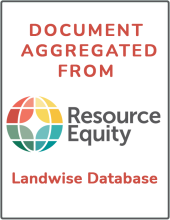Land Library Search
Through our robust search engine, you can search for any item of the over 73,000 highly curated resources in the Land Library.
If you would like to find an overview of what is possible, feel free to peruse the Search Guide.
/ library resources
Showing items 1 through 9 of 112.This report presents results of the 2012 Annual Trends and Outlook for Malawi (ATOR). This is the first ATOR for Malawi.
This first annual trends and outlook (ATOR) report for Swaziland assesses the performance of the agriculture sector in terms of investment, growth, and poverty and hunger outcomes over the period 2000–2011.
Mozambique is the 8th most vulnerable country to climate change and is one of the poorest countries in the world with a high dependency on foreign aid. The population is primarily rural and dependent on agriculture, with 60% living on the coastline.
Zambia recognizes two types of land tenure: customary and leasehold tenure. While historically the majority of land in Zambia has been held under customary tenure, leases (also called leasehold titles) are the only legal means of holding land rights.
This paper, which focuses on the Chinyanja Triangle (CT), an area inside the Zambezi River Basin, characterises three distinct farming subsystems across rainfall gradients, namely maize-beans-fish, sorghum-millet-livestock and the livestock-dominated subsystem.
Land has historically been a source of dispute and conflict in Rwanda, compounded by the social unrest which resulted in the 1994 genocide.
Mozambique has experienced accelerated rates of growth over the past decade, averaging 7.2% per year, with projected growth rates of over 8%.
For the last 60 years, the Korean economy has achieved an astounding development that is called “the Miracle of the Han River.” Korea was one of the world’s poorest countries at the time of the national liberation in 1945 and it went through a three-year long Korean War from 1950.




